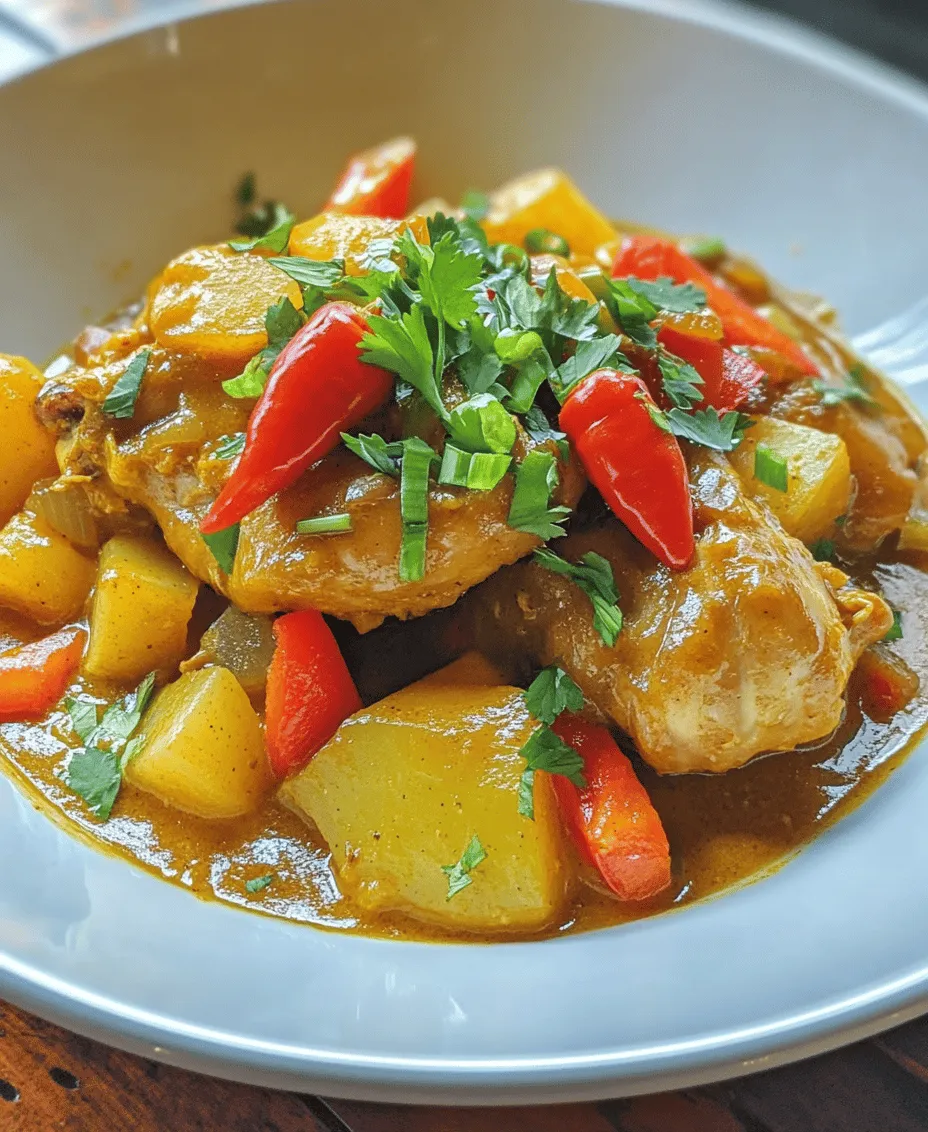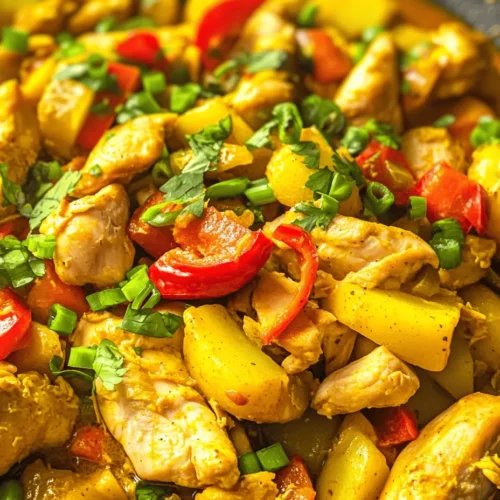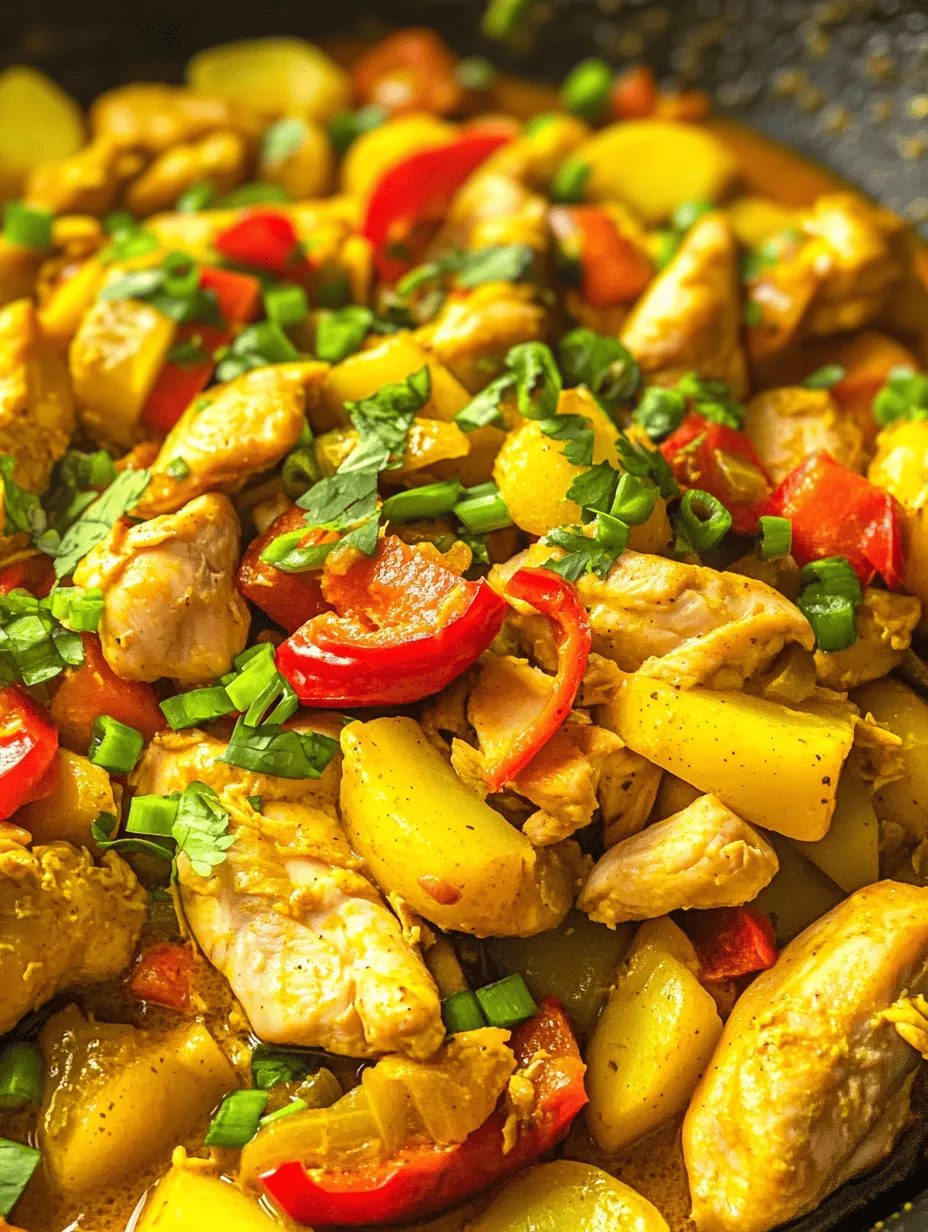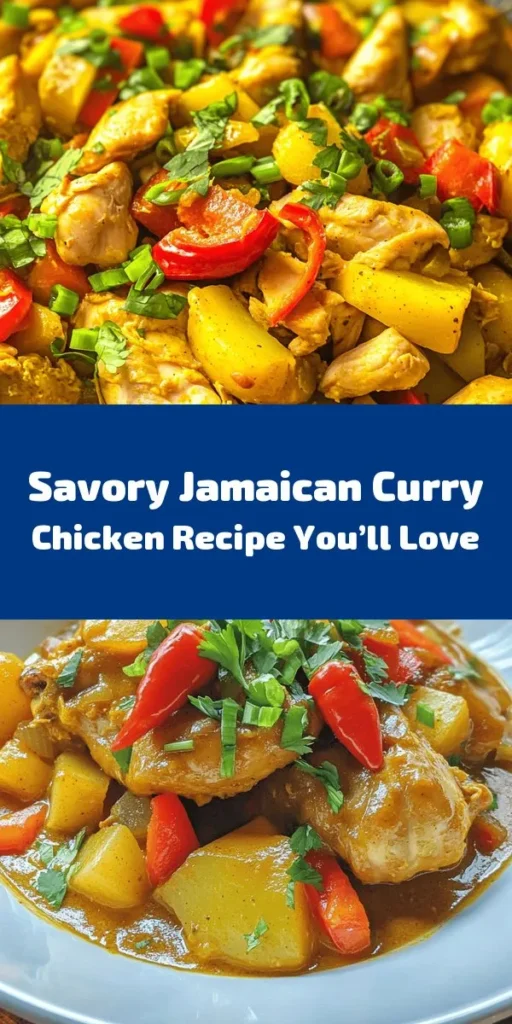Introduction
Jamaican cuisine is a vibrant tapestry of flavors and traditions that reflects the island’s rich history and cultural diversity. From the fiery heat of jerk seasoning to the comforting warmth of rice and peas, Jamaican dishes are known for their boldness and depth. Among these culinary treasures, authentic Jamaican curry chicken stands out as a beloved staple that embodies the essence of the island’s cooking. This dish harmoniously blends spices, herbs, and tender chicken to create a meal that is both satisfying and flavorful.
Curry chicken holds a special place in Jamaican culture, often served at family gatherings, celebrations, and Sunday dinners. It represents a fusion of influences that have shaped the island’s culinary landscape, particularly the impact of Indian cuisine introduced during the 19th century. The marriage of Indian spices with local ingredients has resulted in a unique curry flavor profile that distinguishes Jamaican curry chicken from its counterparts around the world.
In this article, you’ll learn about the rich history and cultural significance of Jamaican curry chicken, explore the essential ingredients that contribute to its distinctive taste, and discover the marination process that enhances flavor. By the end, you will be well-equipped to create your very own authentic Jamaican curry chicken that will transport your taste buds straight to the Caribbean.
Understanding Jamaican Curry Chicken
The History and Origins of Curry Chicken in Jamaica
The roots of curry chicken in Jamaica can be traced back to the arrival of Indian indentured laborers in the 19th century. As they settled on the island, they brought with them their culinary traditions, including the use of spices and curry dishes. Over time, these Indian influences blended seamlessly with traditional Jamaican cooking, resulting in the unique flavor combinations that define Jamaican curry today.
Jamaican curry chicken is characterized by its vibrant yellow color, a result of the use of curry powder, which is often made from a blend of spices such as turmeric, cumin, coriander, and fenugreek. This dish is not just a meal; it tells a story of cultural exchange and adaptation, showcasing how food can bridge different worlds and create something entirely new.
The Influence of Indian Cuisine on Jamaican Cooking
The influence of Indian cuisine on Jamaican cooking extends beyond just curry chicken. Indian spices and cooking techniques have permeated various aspects of Jamaican culinary traditions, leading to the creation of dishes like “curried goat” and “curried shrimp.” The versatility of curry spice blends allows them to be paired with a variety of proteins and vegetables, making it a staple across many Jamaican households.
In Jamaican curry chicken, the spices used are not merely for flavor; they also play a significant role in preserving the meat and enhancing nutrition. The heat from spices like scotch bonnet peppers and black pepper balances the richness of the chicken, creating a harmonious dish that is both delicious and satisfying.
Key Ingredients and Their Roles
To create an authentic Jamaican curry chicken, it is essential to understand the key ingredients that contribute to its flavor and texture. Each component plays a crucial role in building the dish’s character, ensuring that every bite is a celebration of Jamaican culinary heritage.
Chicken: Choosing the Best Cuts
When selecting chicken for your curry, it’s best to opt for bone-in, skin-on cuts. These options not only provide more flavor but also help retain moisture during the cooking process. Thighs and drumsticks are particularly favored in this dish due to their rich taste and tender texture. The bones add depth to the broth, allowing the spices to infuse throughout the meat as it cooks.
Jamaican Curry Powder: Characteristics and Differences
Jamaican curry powder is distinct from other curry powders you may find on the market. It is usually more aromatic and less pungent than Indian curry powders, with a unique blend of spices that often includes turmeric, allspice, and coriander. This particular blend gives Jamaican curry chicken its signature flavor and is what sets it apart from other curry dishes.
When purchasing Jamaican curry powder, look for brands that emphasize authenticity and quality. Some local markets may even offer freshly ground curry powder, which can enhance the dish’s overall flavor profile.
Allspice: Its Unique Flavor and Role
Allspice, known as “pimento” in Jamaica, is a crucial spice in Jamaican cooking. It has a complex flavor that combines hints of cinnamon, nutmeg, and clove, making it an essential ingredient in curry chicken. Allspice contributes warmth and depth to the dish, complementing the heat from the curry powder and scotch bonnet peppers.
In Jamaican curry chicken, allspice is often used in its whole form, allowing its flavor to infuse the dish more subtly during cooking. This spice not only enhances the taste but also adds a fragrant aroma that makes the dish even more enticing.
Vegetables: Importance of Potatoes and Bell Peppers
The inclusion of vegetables in Jamaican curry chicken adds both flavor and texture to the dish. Potatoes are often used to absorb the rich curry sauce, providing a hearty component that balances the meal. They also help thicken the sauce, creating a comforting and satisfying dish.
Bell peppers, typically red and green, add a touch of sweetness and brightness to the curry. Their crunch contrasts beautifully with the tender chicken and potatoes, adding dimension to each bite. You can customize the vegetable selection based on personal preference or seasonal availability, but these staples are commonly found in traditional recipes.
Scotch Bonnet Peppers: Understanding Their Heat and Flavor Profile
No Jamaican curry chicken would be complete without scotch bonnet peppers, known for their fiery heat and distinctive flavor. These peppers pack a punch, often rated among the hottest in the world, but they also contribute a fruity, floral note that enhances the overall complexity of the dish.
When using scotch bonnet peppers, it’s crucial to consider your heat tolerance. You can adjust the amount used based on your preference—removing the seeds and membranes can help reduce the spice level while still allowing the pepper’s unique flavor to shine through. For those who prefer a milder dish, feel free to substitute with jalapeño or another milder pepper, but keep in mind that this will alter the dish’s authentic flavor profile.
Marination Process
Marinating the chicken is a vital step in preparing authentic Jamaican curry chicken. This process allows the flavors of the spices to penetrate the meat, resulting in a dish that is bursting with flavor. Proper marination not only enhances taste but also improves the overall texture of the chicken.
Importance of Marinating Chicken for Flavor Enhancement
Marinating chicken serves several purposes. First, it tenderizes the meat, making it juicy and succulent. The acid in the marinade helps break down proteins, resulting in a more tender bite. Additionally, marination allows the spices to infuse the chicken, ensuring that each piece is packed with flavor.
In Jamaican curry chicken, the marination process typically involves a mixture of curry powder, allspice, garlic, ginger, and scotch bonnet pepper. The longer the chicken marinates, the more pronounced the flavors will be in the final dish.
Step-by-Step Guide to the Marination Process
1. Prepare the Chicken: Start by washing the chicken pieces thoroughly under cold water. Pat them dry with a paper towel to remove excess moisture. This step is crucial for ensuring that the marinade adheres properly.
2. Make the Marinade: In a large mixing bowl, combine Jamaican curry powder, allspice, minced garlic, grated ginger, and chopped scotch bonnet pepper. You can adjust the quantities based on your heat preference. Add a splash of vinegar or lime juice for acidity, which will help tenderize the meat while adding flavor.
3. Coat the Chicken: Add the chicken pieces to the marinade and use your hands to coat each piece thoroughly. Make sure every nook and cranny is covered with the spice mixture.
4. Cover and Refrigerate: Once the chicken is well-coated, cover the bowl with plastic wrap or transfer the chicken to a resealable plastic bag. Place it in the refrigerator to marinate for at least 2 hours, but ideally overnight. The longer the chicken marinates, the more flavorful it will become.
5. Bring to Room Temperature: Before cooking, remove the marinated chicken from the fridge and let it sit at room temperature for about 30 minutes. This step ensures even cooking.
Suggested Marination Time and How It Affects the Final Dish
While a minimum of 2 hours is recommended for marination, allowing the chicken to soak in the spices overnight will yield the best results. This extended marination time allows the flavors to deepen and fully permeate the meat, resulting in a more flavorful and aromatic curry chicken.
In summary, the marination process is a crucial step in preparing authentic Jamaican curry chicken. By taking the time to properly marinate the chicken, you will enhance the dish’s flavor and texture, ensuring that every bite is a delicious celebration of Jamaican culinary traditions. As we continue to explore the cooking process and the steps to create this iconic dish, you will see how each element comes together to create a truly unforgettable meal.

Cooking Techniques for Authentic Flavor
To create an authentic Jamaican curry chicken, mastering a few key cooking techniques is crucial. Each step, from searing the chicken to sautéing aromatics, plays an integral role in developing the rich, complex flavors that characterize this beloved dish.
Searing the Chicken
Searing the chicken is one of the first and most vital steps in preparing Jamaican curry chicken. This technique involves cooking the chicken over high heat until a golden-brown crust forms on the surface. The benefits of browning are twofold: first, it enhances flavor through the Maillard reaction, where sugars and proteins react to create a rich, savory taste; second, it seals in the chicken’s juices, resulting in tender, moist meat.
To achieve the perfect sear, make sure your skillet or pot is hot before adding the chicken pieces. Avoid overcrowding the pan, as this can lower the temperature and prevent proper browning. Instead, sear the chicken in batches if necessary, allowing each piece room to develop that desirable crust.
Sautéing Aromatics
Once the chicken is seared to perfection, the next step is to sauté onions, garlic, and ginger. These aromatics are the backbone of Jamaican curry chicken, providing essential depth of flavor. Onions should be cooked until translucent, releasing their natural sweetness, while garlic and ginger should be added subsequently to prevent burning, as they cook faster.
The combination of these ingredients creates a fragrant base that enhances the overall flavor profile of the dish. As the aromatics sauté, they absorb the fond—the flavorful bits left in the pan from the seared chicken—which adds another layer of complexity. When you smell the inviting aroma wafting through your kitchen, you know you are on the right track.
Combining Ingredients
Layering flavors is a hallmark of good cooking, and Jamaican curry chicken is no exception. After the aromatics have softened, it’s time to add the curry powder and any additional spices. The spices should be stirred in and cooked briefly to bloom their flavors, enhancing the overall taste of the dish. This step ensures that the spices release their essential oils, creating a more vibrant and fragrant curry.
Next, combine the seared chicken back into the pot along with any additional ingredients, such as diced tomatoes or coconut milk, depending on your recipe variation. Carefully folding the components together allows the chicken to coat in the spicy, aromatic mixture, setting the stage for a delicious simmer.
Simmering to Perfection
Simmering is the heart of cooking Jamaican curry chicken. This gentle cooking method allows the flavors to meld and the chicken to become tender and succulent.
Explanation of the Simmering Process
After combining the chicken and other ingredients, add enough liquid—usually water or broth—to cover the chicken halfway. Bring the mixture to a boil, then reduce the heat to low and cover the pot, allowing it to simmer. The low, gentle heat helps the chicken cook evenly while the flavors develop over time.
Simmering is significant because it not only ensures the chicken cooks through but also allows the spices to infuse their flavors into the meat and sauce. This process can take anywhere from 30 minutes to an hour, so patience is key. As the chicken simmers, you’ll notice the sauce thickening and the aroma intensifying, hinting at the deliciousness to come.
Tips for Achieving the Right Sauce Consistency
To achieve the desired sauce consistency, keep an eye on the simmering process. If the sauce appears too thin, you can uncover the pot to allow some liquid to evaporate, thickening the sauce naturally. Conversely, if the sauce becomes too thick, add a splash of water or broth to reach your preferred consistency.
Taste the sauce midway through cooking, adjusting the seasoning with salt, pepper, or additional spices as needed. This step is essential for balancing flavors, ensuring that the dish is neither too salty nor bland.
Serving Suggestions
Jamaican curry chicken is best enjoyed with traditional accompaniments that enhance its flavors and provide a well-rounded meal.
Traditional Ways to Serve Jamaican Curry Chicken
Authentically, Jamaican curry chicken is served over rice or with a side of rice and peas. Rice and peas are a staple in Jamaican cuisine, made with kidney beans, coconut milk, scallions, and spices, which complement the spicy, bold flavors of the curry chicken beautifully.
Another popular serving method is to place the curry chicken on a platter, allowing guests to help themselves, creating a communal dining experience that’s central to Jamaican culture.
Recommended Side Dishes
In addition to rice and peas, consider serving Jamaican curry chicken with steamed vegetables such as carrots, broccoli, or green beans. These vegetables add color and nutritional value to the meal while balancing the richness of the curry.
Fried plantains are another delightful side, offering a sweet contrast to the savory curry. Their caramelized exterior and soft interior provide a lovely texture that works well with the spiciness of the dish.
Presentation Tips for a Beautiful, Authentic Jamaican Meal
For a stunning presentation, serve the curry chicken in a large bowl garnished with chopped fresh cilantro or scallions. Placing a few lime wedges on the side adds a pop of color and offers a fresh zesty contrast when squeezed over the dish. Use vibrant, colorful dishes to showcase the rich hues of the curry and the accompanying sides, inviting diners to dive into this flavorful meal.
Cultural Significance of Curry Chicken
Jamaican curry chicken is not just a dish; it embodies the spirit of Jamaican hospitality and is a staple in celebrations and family gatherings.
The Role of Curry Chicken in Jamaican Celebrations
In Jamaica, curry chicken holds a special place during festivities such as birthdays, weddings, and family reunions. It’s often the centerpiece of the meal, symbolizing unity and joy. The process of cooking and sharing this dish brings people together, fostering connections and creating lasting memories.
Reflecting the Spirit of Jamaican Hospitality
Jamaican hospitality is renowned for its warmth and generosity. When guests are welcomed with a hearty plate of curry chicken, they experience not just a meal but a taste of the island’s rich culture and traditions. Sharing food is a fundamental aspect of Jamaican life, and curry chicken is a dish that embodies this spirit perfectly.
Personal Anecdotes or Quotes from Jamaican Chefs or Home Cooks
Many Jamaican chefs and home cooks emphasize the importance of making curry chicken with love and care. As Chef Tanesha, a renowned Jamaican cook, states, “Cooking is about the heart. When you prepare curry chicken, you’re not just making a meal; you’re sharing a piece of your culture and history with others.” This sentiment resonates deeply with those who cherish their culinary heritage and strive to pass it down through generations.
Conclusion
The journey of creating authentic Jamaican curry chicken is filled with rich flavors, cultural significance, and heartwarming traditions. From the careful selection of spices to the loving preparation and presentation, each step is a tribute to the vibrant culinary landscape of Jamaica.
As you explore this recipe, remember that cooking is not just about following instructions; it’s about embracing the experience and sharing it with loved ones. The joy of serving this dish at your table will not only delight your taste buds but also foster connections and create cherished memories.
Encouragement to explore and embrace Jamaican cuisine in home cooking is essential. Whether you are a seasoned cook or a novice, take the time to appreciate the stories behind each ingredient and the love infused into every bite. Jamaican cuisine is an invitation to explore bold flavors and celebrate community, so gather your friends and family, and enjoy the delightful experience of Jamaican curry chicken together.



